Get rid of the boxes
Get rid of the boxes
by
Jean Luc Cornille
Sept 03 2013
“Instead of thinking outside of the box, get rid of the box”
In the equestrian world, the “boxes” are theories based on equestrian literature but unrelated to actual knowledge of the equine physiology. Fred Ritchin wrote, “We are being sold products and social scenarios that appeal to our fantasies but ultimately fail us.” This applies to numerous training techniques. They appeal to our fantasies but they ultimately fail both, the horses and the riders. The first box to get rid of, is the mean value theorem.
If you remember the years in high school, “given a planar arc between two endpoints, there is at least one point at which the tangent to the arc is parallel to the secant through its endpoints.” During these years, I was physically in the class room but mentally with the horses. I immediately integrated the theorem to the training techniques. We act on both ends of the horse thoracolumbar column, the hind legs at one end of the neck at the other end with the mean of creating an arc with the thoracolumbar spine.
The belief that the horse’s lower line, pectoral and abdominal muscles flexes the upper line, the thoracolumbar curvature, has been perpetuated through centuries. Elementary studies between insertion and attachments of main muscles created “simpler” theories. In the light of today’s knowledge, our ancestors’ views of equine functional anatomy were naïve. However, they strongly believed that their views were at the cutting age. For instance, at the eighteen century, the Marquis of Condorcet (1743-1794) believed that the study of anatomy was already completed. In fact, a century earlier, , “All knowledge was already known” (William Machester) was the belief that initiated the “renaissance.”
Due to its position under the rider’s legs, the rectus abdominis muscle, which spread from the adjacent part of the sternum to the prepuberis tendon of the pelvis area, was believed to be the muscle engaging the hind legs and flexing the back. In 1945, L. J. SLijper investigated the angle of the equine dorsal spine. Slijper was one of the firsts to believe that the inclination of the dorsal spines was related to the forces exerted by the main back muscles. The Dutch scientist found unusual support with the birth of a goat which had no front legs. The goat learned how to stand and move on her hind legs. If Slijper’s theory was right, the dorsal spines of the bipedal goat should have a different orientation than the dorsal spine of a normal goat. Effectively, the dorsal spines were oriented differently. This illustration shows on the top, the thoracolumbar column of the bipedal goat and by comparison at the bottom, the thoracolumbar spine of a normal goat. 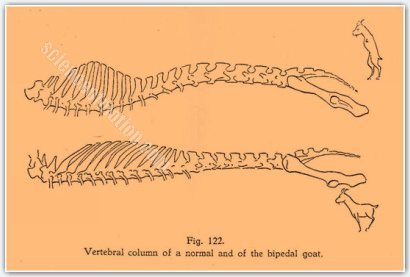
Slijper’s finding could have been the beginning of the new level of thinking which attributes to the back muscles the capacity of lifting the back. Curiously, the Dutch scientist aligned his theory of thoracolumbar flexion with conventional beliefs. Slijper emphasized the “Bow and String” concept. The back is like a “bow,” Which is composed of the thoracolmbar spine and back muscles, and that can be flexed by the tension of the “string.”
Several scientists questioned the theory. The most pertinent observation was certainly the remark of James Rooney. 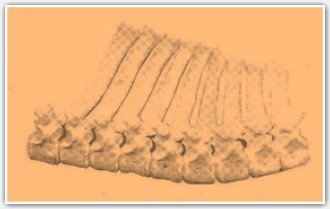 Lordosis or sway back is created by a problem at the level of hypoplastic joints.
Lordosis or sway back is created by a problem at the level of hypoplastic joints.
The following diagram that is copied from James Rooney’s “Biomechanics of lameness in horses,” shows the evolution of hypoplasia. 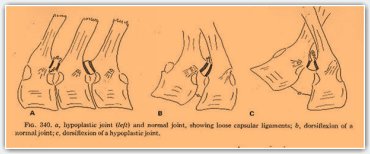 The diagram needs to be read from left to right. The junction between the first and second vertebra on the left shows hypoplastic joint with loose capsular ligament. By comparison, the next joint between the second and third vertebrae is normal. Due to the instability
The diagram needs to be read from left to right. The junction between the first and second vertebra on the left shows hypoplastic joint with loose capsular ligament. By comparison, the next joint between the second and third vertebrae is normal. Due to the instability
created by the loose capsular ligament, the vertebrae start rotating creating sway back. When overextension has occurred at one or more joints, the spine is unstable. Stability is then tentatively recreated bending the thoracolumbar column structure around the stronger muscles group, which are the back muscles situated above the vertebral bodies. Stability is then recreated through the development of sway back, (lordosis).
If Slijper’s theory was right, and therefore if abdominal muscles had the capacity to flex the back muscles, the stability of the unstable thoracic spine would be recreated around the abdominal muscles and the result would be kyphosis, or ”roached back,” instead of sway back. This picture shows a case of kyphosis.

“ Slijper compared the vertebral coumn to an elastic bow bent to the normal position by the “string” Sternum, abdominal muscles, linea alba, extrinsic muscles of the legs). If this were true, one would expect kyphosis rather than lordosis. Overflexion of the hypoplastic joints rather than extension. The torque around the center of rotation of the vertebrae, the intervertebral disk- is a product of forces (muscles) times the distance from the center of rotation. Since overextension rather than overflexion occurs when there is hypoplasia of the intervertebral articulations, we must assume that the force developed by the dorsal back muscles, together with the force of gravity, is greater than that force exerted by the string muscles.” (James R. Rooney, 1976)
We place side by side two illustrations. 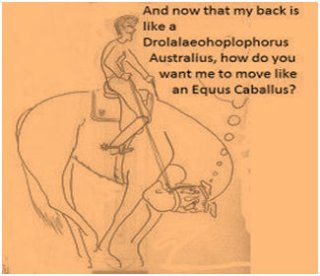
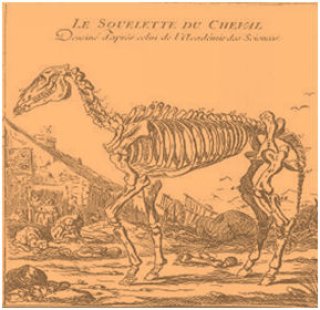
The horse skeleton that has been drawn in respect of a skeleton exposed at the museum of the French Academy of Science at the époque of Monsieur de la Gueriniere (18th Century). As you know, 60% of the museum reconstitutions are wrong. This one is very wrong. The pelvic is placed like the one of a dinosaur and the round shape alignment of the thoracolumbar column is more in line with common beliefs than reality.
James Rooney also addresses a common misunderstanding about the “round back.” Riders think in terms of postural alignment when in fact, “round back” is a metaphor describing the feeling of vertical forces. Our ancestors interpreted the perception of vertical forces as a shape of the horse thoracolumbar spine and the misinterpretation lead to training technique trying to create a shape, “round back”, which is reality, does not exist. In some instances, Rooney refers to the work of Slijper for the description of the vertebrae but he also disagree with some of the Dutch scientist views. “Slijper consider the bow to be elastic, assuming a straighter form when the string, abdominal muscles, is removed Virchow stated that the bow remained after all musculature was removed leaving only the vertebrae and the ligaments.”
The horse thoracolumbar spine maintains effectively its thoracolumbar curvature when all muscles have been removed leaving only the vertebrae and ligaments.
This is the usual shape of the horse thoracolumbar spine. The shape is referred to as the “thoracolumbar curvature”. This shape remains even after removing all muscles.
It is interesting to observe the difference between the interpretations of riders, and the view of scientists who are aware of the muscles’ structure of function. Riders, who like to think in terms of muscle shortening and stretching, think about abdominal muscles shortening and flexing the thoracolumbar spine, (concentric contraction.) By contrast, pathologists, who know firsthand that abdominal muscles don’t have the capacity to overcome the mass and power of the back muscles, think in terms of resisting elongation, (isometric or eccentric contraction.)
This is the cross section of a specimen at the level of the second lumbar vertebrae.  The section of the rectus abdominis is held between the hands of the pathologist. You can now understand why pathologists do not believe in the bow and string theory. Abdominal muscles do not have the capacity to overcome the mass and power of the back muscles. Rectus abdominis and forelegs extrinsic muscles participate in the flexion of the thoracolumbar spine but they are not capable to create it. Longitudinal flexion of the thoracolumbar spine, or more exactly, creation of vertical forces, is the task of the main back muscles that are situated above the vertebral bodies. Their coordination is created by the rider’s back. Collection is therefore much more the task of the rider’s back than the combined action of the hands and legs.
The section of the rectus abdominis is held between the hands of the pathologist. You can now understand why pathologists do not believe in the bow and string theory. Abdominal muscles do not have the capacity to overcome the mass and power of the back muscles. Rectus abdominis and forelegs extrinsic muscles participate in the flexion of the thoracolumbar spine but they are not capable to create it. Longitudinal flexion of the thoracolumbar spine, or more exactly, creation of vertical forces, is the task of the main back muscles that are situated above the vertebral bodies. Their coordination is created by the rider’s back. Collection is therefore much more the task of the rider’s back than the combined action of the hands and legs.
This brings us to a second box handicapping progresses. This box is the belief that amplitude of movements, lightness and elasticity can be achieved through stretching and relaxation. As humans, we associate ease with relaxation, the meaning of which is effortlessness. The problem is that relaxation also means lack of muscle tone and we like to think that less muscle tone would lead the horse to ease, lightness and elasticity. When it came to horses, nature had to resolve a very specific problem. How to conceive a creature which, in spite of being horizontal, tall and heavy, could run faster and further away than her predators. Nature created an impressive model of energy saving and efficiency. However, even if this model is built, like humans, with bones, muscles, tendons and ligaments, it functions very differently than the human model. The main adaptation has been reducing the work of muscles by increasing the involvement of long tendons and their capacity of storing and releasing elastic strain energy. This differs widely from human locomotion. For instance, some therapies will tell you that moving manually the front or rear limb of a horse standing still will enhance its range of motion elongating specific muscles. This is severe misunderstanding of the equine locomotor mechanism. The same can be said from training techniques acting on the hind and front legs and pretending that acting on the horses’ limbs enhances the horses’ performances.
A great part of the horse locomotion relies on elastic strain energy stored and released by the lower legs’ long tendon. The superficial digital flexor tendon is quite elastic and attached to the superficial digital flexor muscle that is constructed with short fibers. As the tendon elongates under the stress of impact forces, the superficial digital flexor muscle resists elongation through isometric hold. If the muscle elongated as suggested by simplistic theories, the tendon would not store much energy and the amplitude of the stride would be markedly reduced. The same principle directs the work of the deep digital flexor tendon even if the tendon is thicker and less elastic. The deep digital flexor tendon is attached to the deep digital flexor muscle, which has longer fibers and therefore capable of more compliance. However, the fascicles of the deep digital flexor muscles resist impact forces allowing greater elastic strain energy of the tendon.
Further studies have demonstrated that muscles, include back muscles, are built with cells fibers that contract and tendinous materials, which are working like tendons. Muscles store and recover energy even in the absence of tendons. “Apart from the role of tendons and collagen in energy storage, the muscle itself stores and recovers elastic strain energy, as elastic strain energy can occur in the absence of tendons” (Paul C. LaSrayo and all) This new knowledge opens a totally different perspective. Stretching and relaxation are theories that appeal to our fantasies but are not even close from the real functioning of the horse’s muscular system. In fact, release and stretching are more likely creating instability than elasticity. Instability is counteracted by protective reflex contraction. By contrast, elasticity is the outcome of proper tone and frequency between muscle cells and connective tissues. “In a sense, because the muscle is composed of both muscle fibers and tendinous materials, all of these structures must be collectively ‘tuned’ to the spring properties for the muscle-tendon system to store and recover elastic strain energy during locomotion.” (Paul C. LaStayo, PT, PhD. John M. Woolf, PT, MS, ATC. Michael D. Lewek, PT. Lynn Snyde-Mackler, PT, ScD. Trugo Relch, BS. Stan L. Lindstedt, PhD. Eccentric Muscle Contractions: Their contribution to injury, prevention, rehabilitation, and sport. Journal of Orthopaedic & sports physical therapy. 557-571. Volume 33, NUMBER 10, October 2003)
Tuning the muscles is the basis of the equestrian art. It is an art of subtlety situated between relaxation and contraction. Bad training techniques do not identify the source of protective reflex contractions. They try releasing the contraction through stretching and relaxation, furthering instability. People who want to keep their head in the box always argue that “there is a way to do it right.” There is no way to do right a technique or concept that is fundamentally wrong. The antidote of contraction is coordination, which include creating appropriated muscle tone. The tools of modern riders are not neck gesture, legs gestures, hands gestures creating gestures that the horse executes with a dysfunctional body. The tools of modern riders are frequency, nuances in muscle tone, elastic strain energy. Riding better horses or more exactly allowing every horse performing soundly and at their full potential demands understanding the horse’s physique and equine athletic performances updated to new knowledge. We provide such knowledge constantly enhancing our online course, creating new events, furthering knowledge.
Knowledge is the solution. It is the cure to misconceptions that are keeping riders in a box. The light out of the box is fascinating; get rid of the box.
.
Jean Luc Cornille
Click for IHTC In Hand Therapy Course Information



 twitter
twitter facebook
facebook digg
digg google
google stumbleupon
stumbleupon pinterest
pinterest yahoo
yahoo linkedin
linkedin